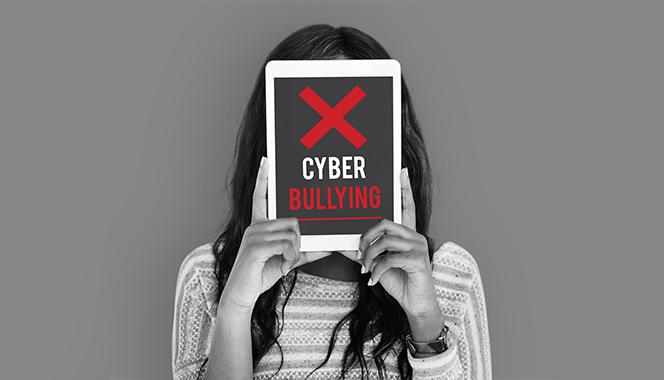In this Digital world, it is also
important to understand the problems and crimes that may come with wide access
to the internet. There needs to be special rules and regulations for such
crimes and one also needs to know these rules and how to protect or defend
themselves online.
The following article gives
knowledge on these crimes and the rules against them.
Cyberbullying
The
US National Crime Prevention Council defines cyberbullying as "the process
of using the Internet, cell phones or other devices to send or post text or
images intended to hurt or embarrass another person."In short, harassment of an individual using
any digital means is cyberbullying.
Bullying is not restricted to
schools, playgrounds, or college campuses, now it is way easier for
perpetrators to go online and bully someone.
Due to the increase in the use of the internet anybody can be a victim
or perpetrator of cyberbullying. It is seen that cyberbullying is done not
online by friends and someone you know even a stranger can easily bully a
person.
Components of Cyberbullying
1. Use of harsh words
2. Intention to embarrass, harass and
insult the victim
3.
Convey
the above via information and communication technology and/or digital
communication technology
Types of cyberbullying
There
are various types of cyberbullying. To understand laws regarding cyberbullying
it is also important to know the types of cyberbullying.
- Flaming: involves sending offensive or
hurtful texts, messages, or emails, directly to the victim. Vulgar and
abusive words are sent which are aggressive in nature. Flammer may engage
in insulting someone’s race, caste, sex or status, etc.
- Harassment: a person receives threatening or hateful messages.
These messages usually follow a constant pattern with the intent to hurt.
Harassment has 3 traits. One-it is severe for example, the person
receiving death threats, two-it is pervasive wherein it might seem minor
but can harm the person on receiving end and three-it is online.
- Exclusion: In this type of cyberbullying an individual is excluded
deliberately from a group and posting malicious comments/messages about
them.
- Impersonation: Impersonation is when a person makes fake profiles
and accounts to destroy one’s reputation in society by sharing personal
information about them whether real or fake.
- Frapping: when someone uses a person’s social media account to post
inappropriate content under that person’s name, the same is considered to
be frapping. This is done to ruin the person’s reputation.
- Cyberstalking: Cyberstalking is a serious offense where the victim
receives threatening messages. It also includes physical threats. Here the
victim is monitored and followed online.
- Trolling: When inflammatory comments are posted about a person
intentionally to disturb him or her mentally, the same is termed as
trolling.
Laws for Cyberbullying
Punishments for cybercullying are
listed under Information Technology act, 2000.
Section 66A: deals with the punishment for sending messages or
emails which are harmful or abusive in nature through the internet or any other
platform.
It
is also punishable under the provision when someone shares information that he
believes to be false. Punishment: 3 years inprisonment if message found
offensive. However, this provision was struck down in 2015 as it violates
freedom of speech.
Section 66C: deals with the punishment for using electronic
signature, password or any other identification feature of any other person
dishonestly or fraudulently. Punishment: 3 years or 1 lakh fine.
Section
66D: deals with an individual who cheats by personation using any social media
or communication device for fraudulently pretending to be another person.
Section
66E: deals with privacy of person’s body. It says taht it is illegal to capture
person’s photographs, publish or transmit such image or film without consent of
such person, violating their privacy.
Section
67: deals with publishing or transmitting any material which is obscene in
nature and if such material tends corrupt people to read, hear or see the
material, it would be considered as an offence. Punishment: 3 years with fine
up to 5 lakhs.
Section
67A: deals with penalising the publishing or transmission of any material which
contains sexually explicit content or act. Punishment: 5 years also with a fine
up to 10 lakh.
Section
67B: deals with materials that depict children in sexually explicit act or
conduct. Any person creating or such transmitting such material is punishable.
Section
292A of IPC, 1860: deals with the printing of any matter in grossly indecent
manner or matter intended for blackmail. Taking part in or receiving any profit
from such business which includes sale, import, export or printing etc, of such
materials or advertising the same which would be injurious to morality, is
punishable.
Section
354C of IPC, 1860: deals with voyeurism, Voyeuriem is watching or capturing
images of a women engaged in some private act in such circumstances where she
presumes privacy or spreads such images to a third party, would be considered
as an offence. Females are not punished under this provisions. Punishment: 1
year and this may extend to 3 years with a fine.
Section
354D of IPC,1860: deals with when a man follows a woman to establish contact
between then inspite of clear disinterest from the woman or monitors online
activity or a woman.
Section
499 of IPC, 1860: deals with defamationit that includes any speech or document
in online format which are posted on online platforms by any person which tends
to harm the reputation of any other person. Punishment: simple imprisonment
which may extenf up to 2 years or fine or both.
Section
507 of 1PC, 1860: deals with any person who through a fake identity or through
an unknown telecommunication source, threatens another person.
Reporting of cyberbullying
●
Identify and block the bully's phone number
to prevent him/her from sending messages.
●
Save all the chats, posts, and emails
sent by the bully, to be used as evidence.
●
Report the bully's phone number/account
details to the service providers - all social networking platforms have this
facility.
●
If the bullying continues, register a
complaint at the cybercrime cell of the local police.
Conclusion
Cyber crimes are on the rise and
awareness regarding its laws and consequences is necessary. Cyberbullying is
the most common type of cybercrime. The extent of these crimes is not clearly
defined under Indian laws and it is necessary that more light is put into
cybercrime. One should be aware of what precautions a person should take to
keep themselves and their children safe while being online. Awareness about
what to do when one becomes a victim of these crimes is also necessary.




